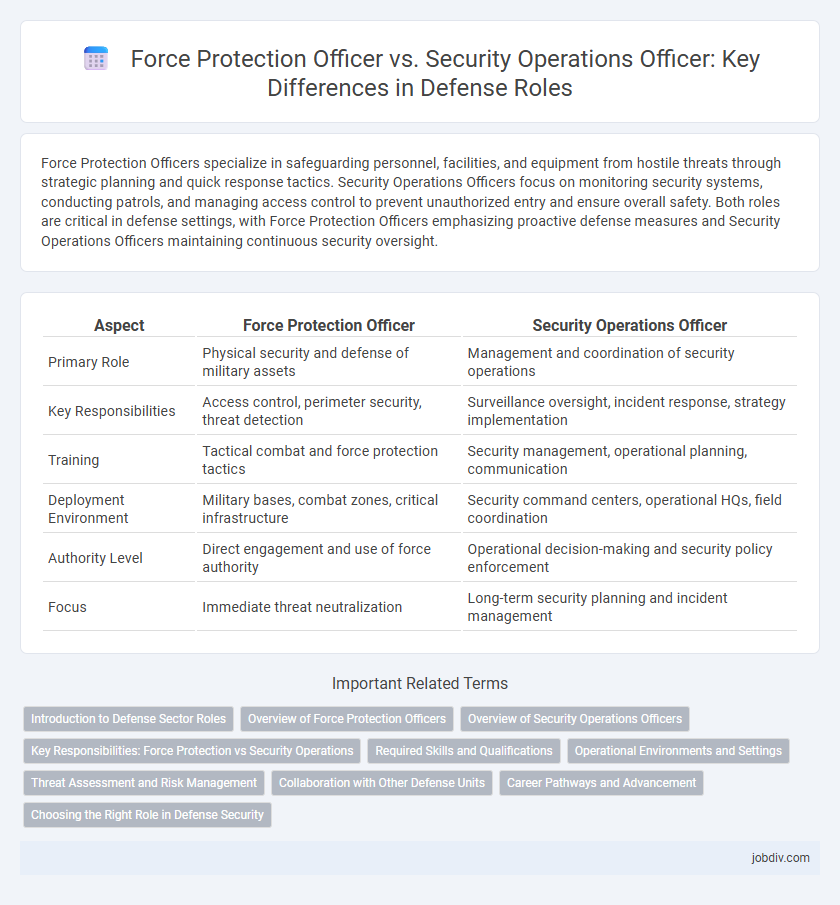Force Protection Officers specialize in safeguarding personnel, facilities, and equipment from hostile threats through strategic planning and quick response tactics. Security Operations Officers focus on monitoring security systems, conducting patrols, and managing access control to prevent unauthorized entry and ensure overall safety. Both roles are critical in defense settings, with Force Protection Officers emphasizing proactive defense measures and Security Operations Officers maintaining continuous security oversight.
Table of Comparison
| Aspect | Force Protection Officer | Security Operations Officer |
|---|---|---|
| Primary Role | Physical security and defense of military assets | Management and coordination of security operations |
| Key Responsibilities | Access control, perimeter security, threat detection | Surveillance oversight, incident response, strategy implementation |
| Training | Tactical combat and force protection tactics | Security management, operational planning, communication |
| Deployment Environment | Military bases, combat zones, critical infrastructure | Security command centers, operational HQs, field coordination |
| Authority Level | Direct engagement and use of force authority | Operational decision-making and security policy enforcement |
| Focus | Immediate threat neutralization | Long-term security planning and incident management |
Introduction to Defense Sector Roles
Force Protection Officers specialize in safeguarding military personnel, assets, and facilities from threats through tactical security measures and threat assessments. Security Operations Officers manage broader security programs, coordinating surveillance, access control, and emergency response within defense installations. Both roles are essential for maintaining operational readiness and ensuring comprehensive defense sector security.
Overview of Force Protection Officers
Force Protection Officers specialize in safeguarding military personnel, installations, and assets through threat assessment, risk management, and coordinated security measures. They implement tactical procedures, conduct patrols, and oversee access control to prevent unauthorized entry and mitigate potential threats. Their role integrates intelligence analysis with physical security protocols to ensure mission continuity and operational resilience.
Overview of Security Operations Officers
Security Operations Officers oversee the planning and execution of comprehensive security protocols within military installations, ensuring the safety of personnel and assets against potential threats. They coordinate surveillance systems, manage emergency response efforts, and conduct risk assessments to maintain operational readiness. Their role integrates intelligence analysis with tactical enforcement to mitigate vulnerabilities and enhance force protection measures.
Key Responsibilities: Force Protection vs Security Operations
Force Protection Officers focus on identifying and mitigating threats to personnel, facilities, and assets through proactive risk assessment, threat analysis, and implementation of defensive measures. Security Operations Officers manage the daily execution of security protocols, including access control, surveillance, incident response, and coordination with law enforcement agencies to maintain operational security. Both roles emphasize safeguarding military infrastructure but differ as Force Protection prioritizes strategic threat prevention while Security Operations emphasizes tactical security enforcement.
Required Skills and Qualifications
Force Protection Officers require expertise in threat assessment, tactical response, and advanced firearms proficiency to safeguard personnel and assets in high-risk environments. Security Operations Officers must possess strong surveillance, incident response, and facility security management skills to maintain secure operational areas. Both roles demand physical fitness, clear communication abilities, and comprehensive knowledge of defense protocols and emergency procedures.
Operational Environments and Settings
Force Protection Officers primarily operate in high-threat military environments, including forward operating bases and conflict zones, where they ensure the safety of personnel and critical assets against hostile actions. Security Operations Officers typically manage security protocols in more controlled, static environments such as military installations, government facilities, and logistics hubs, focusing on access control, surveillance, and emergency response coordination. Both roles require expertise in threat assessment and situational awareness, but Force Protection Officers often engage in active defense measures under combat conditions, whereas Security Operations Officers emphasize preventive security and operational continuity.
Threat Assessment and Risk Management
Force Protection Officers specialize in threat assessment by identifying and mitigating risks to personnel, facilities, and operations within military environments, employing tactical intelligence and real-time threat analysis. Security Operations Officers focus on comprehensive risk management strategies, integrating physical security measures, access control, and surveillance technologies to safeguard assets and maintain operational continuity. Both roles collaborate to enhance situational awareness and implement proactive countermeasures against evolving security threats.
Collaboration with Other Defense Units
Force Protection Officers coordinate closely with combat units and intelligence teams to implement defensive measures and ensure personnel safety. Security Operations Officers collaborate with military police and homeland security agencies to monitor threats and manage access control across critical facilities. Both roles require integrated communication and joint planning to optimize force protection and operational security in defense environments.
Career Pathways and Advancement
Force Protection Officers typically advance through specialized military or defense roles, gaining expertise in tactical operations, threat assessment, and emergency response, which enhances their eligibility for leadership positions in combat or security units. Security Operations Officers often follow a career path within law enforcement or private security sectors, focusing on surveillance management, risk mitigation, and compliance, which can lead to senior operational management or corporate security director roles. Both careers require ongoing training and certifications that influence advancement opportunities and sector-specific leadership capabilities.
Choosing the Right Role in Defense Security
Force Protection Officers specialize in safeguarding military personnel and assets through risk assessment, threat detection, and physical security measures, making them essential in high-risk operational environments. Security Operations Officers manage security protocols, coordinate response strategies, and oversee surveillance systems, providing comprehensive protection across defense installations. Choosing the right role depends on operational requirements, with Force Protection Officers suited for frontline defense and Security Operations Officers ideal for managing broader security infrastructure.
Force Protection Officer vs Security Operations Officer Infographic

 jobdiv.com
jobdiv.com